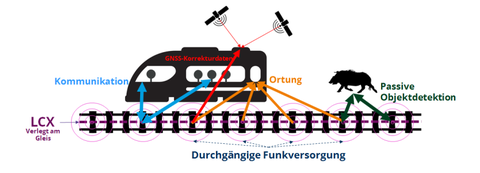Leaky coaxial cables (LCX) for linear broadband radio coverage, high-availability vehicle location and radar-like obstacle detection in automated SRCC railroad operations
As part of the funding line "Change through Innovation in the Region (WIR!)" of the Federal Ministry of Education and Research, technologies in the Smart Rail innovation field are being developed and tested at the Smart Rail Campus in Annaberg-Buchholz. Within this project cluster, innovative applications of leaky coaxial cables (LCX) technology in rail transport are being investigated in the LCX4Rail project.
Project scope
The seamless provision of communications services for rail vehicles is a prerequisite for attractive rail passenger services and lays the foundation for automated operating procedures in rail traffic. However, the geographical requirements of track routing (valleys, tunnels) mean that conventional networking solutions require a large number of base stations or repeaters. This is where the LCX4Rail project scope is focused. Leaky coaxial cables (LCX) enable reliable radio coverage along a linear corridor and are therefore particularly suitable for the topological requirements of rail traffic. Technically, LCX technology involves coaxial cables whose shielding contains slot-shaped openings through which the cable acts as an antenna. This technology is already used in metro/subway systems and is also planned for new mainline rail lines. One goal of the project is to investigate the applicability of this approach for retrofit, particularly on regional rail lines. LCX technology also offers possibilities for rail applications that go beyond pure radio coverage, and these will be examined in the project. On the one hand, the technology can be used for positioning and positioning integrity procedures. On the other hand, it can be used as a passive radio radar to detect objects and obstacles in the track area (see figure).
In summary, the project objective is to investigate the applicability of LCX technology in rail transport. Three use cases are considered:
- Broadband radio coverage
- Radio-based vehicle localization and location integrity
- Passive onject sensing for obstacle detection
Work packages ITVS
- Availability analysis for radio services based on radio simulation
- LCX-based positioning and integrity monitoring
- Passive object detection using LCX-UWB radar
- Long-term data analysis
Project partners
- TU Chemnitz (Center for Technology Transfer und Professorship Communications Engineering)
- ibes AG (Chemnitz)
- MRK Media AG (Dresden)
- Smart Rail Campus (Annaberg-Buchholz, associated)
Project duration: 01.03.2023 - 28.02.2025
Project executing organisation: Projektträger Jülich
Grantor: Federal Ministry of Education and Research, Wandel durch Innovation in der Region (WIR!)
Grant: 221.000€
Kontakt: Albrecht Michler

